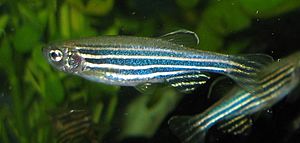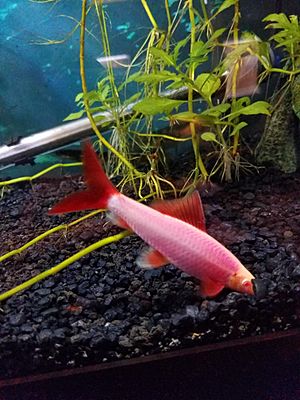GloFish facts for kids
Quick facts for kids GloFish |
|
|---|---|
 |
|
| Organism | Zebrafish (Danio rerio)
Black tetra (Gymnocorymbus ternetzi) Tiger barb (Puntius tetrazona) Rainbow shark (Epalzeorhynchos frenatum) |
| Mode | Transgenesis |
| Method | Insertion |
| Vector | Multiple including green fluorescent protein |
| Developer | Yorktown Technologies, L.P. |
| Trait(s) conferred | Fluorescent colors |
| Genes introduced | Multiple |
GloFish are a special kind of fish that glow! They are a brand of fish that have been changed using science to make them glow in bright colors. These glowing fish are created from several different types of fish. The first GloFish sold in pet stores were zebrafish (Danio rerio). Later, other types like tetra (Gymnocorymbus ternetzi), tiger barbs (Puntius tetrazona), Rainbow Sharks (Epalzeorhynchos frenatum), Siamese fighting fish (Betta splendens), and Bronze corydoras (Corydoras aeneus) were added.
You can find GloFish in many cool colors. These colors have special names like "Starfire Red", "Moonrise Pink", "Sunburst Orange", "Electric Green", "Cosmic Blue", and "Galactic Purple". Not all fish types come in every color. Even though they weren't first made to be pets, GloFish were one of the first animals changed by science that people could buy. The company Spectrum Brands, Inc. now owns the rights to GloFish. They bought GloFish from Yorktown Technologies in 2017.
Contents
How GloFish Were Developed
The Start of Glowing Fish
The original zebrafish is a small fish, about three centimeters long. It lives in rivers in India and Bangladesh and has gold and dark blue stripes.
In 1999, a scientist named Dr. Zhiyuan Gong and his team in Singapore were working with a special gene. This gene came from a jellyfish and made things glow bright green. They put this gene into a zebrafish egg. The gene became part of the fish's DNA, making the fish glow brightly under both regular light and UV light.
Their main goal was to create a fish that could help find pollution. They hoped the fish would glow in a special way when harmful chemicals were in the water. Making a fish that glowed all the time was the first step in this plan.
Soon after, Dr. Gong's team made red glowing zebrafish by adding a gene from a sea coral. They also made orange-yellow glowing zebrafish using a different version of the jellyfish gene. Around the same time, another team in Taiwan made a green glowing medaka fish. Medaka are also used in science, like zebrafish.
Bringing GloFish to the World
The scientists from Singapore met with Alan Blake and Richard Crockett from Yorktown Technologies, a company in Austin, Texas. They made a deal for Yorktown to sell the glowing zebrafish all over the world. Yorktown then named them "GloFish".
At the same time, a company in Taiwan called Taikong started selling the green medaka fish in Taiwan. These were called TK-1. In 2003, Taiwan was the first place to allow a genetically changed animal to be sold as a pet. They reportedly sold 100,000 fish in less than a month! The glowing medaka are not GloFish, as they are sold by a different company.
GloFish in the United States
GloFish came to the United States in late 2003. The U.S. Food and Drug Administration (FDA) checked if the fish were safe for the environment. The FDA looks at all genetically changed animals because they see the added gene as a kind of medicine.
In December 2003, the FDA decided that GloFish were safe. They said: "Because tropical aquarium fish are not used for food, they don't threaten our food supply. There's no proof that these genetically engineered zebra danio fish are any more dangerous to the environment than regular zebra danios, which have been sold for a long time. Since there's no clear risk, the FDA sees no reason to control these particular fish."
Some groups were worried about GloFish being sold. They thought it might make it easier for other genetically changed animals to be approved without enough checks. One group even tried to stop the sales, but their lawsuit was dismissed in 2005.
New GloFish Colors and Types
After the red zebrafish, Yorktown Technologies released green and orange-yellow zebrafish in 2006. In 2011, blue and purple zebrafish came out. These fish get their colors from genes from sea coral.
In 2012, Yorktown Technologies introduced a green GloFish made from a different fish species, the black tetra. Then came a green tiger barb. In 2013, orange, pink, and purple Tetras were released, making Tetras the first GloFish to be available in pink. Red and blue Tetras followed in 2014. The colors still have their special names: "Starfire Red", "Moonrise Pink", "Sunburst Orange", "Electric Green", "Cosmic Blue", and "Galactic Purple".
Other GloFish include the GloFish shark, which comes in orange, green, and purple. These fish are based on the albino rainbow shark. In 2020, green GloFish bettas (also called Globettas) were released. They come in female, young male, and adult male versions.
Some people thought GloFish eggs were treated so they couldn't have babies. But it turns out some GloFish can have babies in a home aquarium. However, the GloFish license says you are not allowed to intentionally breed or sell any GloFish offspring.
GloFish were not allowed in California for a while because of rules about genetically changed fish. These rules were put in place before GloFish were sold, mainly because of concerns about a fast-growing salmon. But in 2015, California lifted these rules. Now, GloFish can be legally imported and sold there.
GloFish are not allowed to be imported, sold, or owned in the European Union. However, in 2006, some glowing fish were found being sold in aquarium shops in the Netherlands.
In 2014, studies looked at how safe GloFish are for the environment. One study found there was little risk of them spreading into the wild. Another study said there was no difference in risk between GloFish and regular fish.
How GloFish Interact with Predators
Studies have shown that GloFish might be easier for predators to catch than regular fish. In experiments, red glowing zebrafish were about twice as likely to be eaten by fish like largemouth bass and eastern mosquitofish. These predators are found in the wild and could potentially eat fish that escape into nature.
GloFish and Reproduction
Scientists have also studied how GloFish mate. In some studies, regular male zebrafish had a big advantage over GloFish males when it came to mating. This was because the regular males were more aggressive. However, in other studies by the same group, female zebrafish actually seemed to prefer the GloFish males!
|



